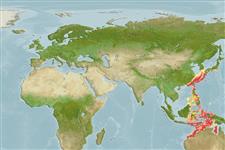>
Perciformes/Uranoscopoidei (Sand dwellers) >
Ammodytidae (Sand lances)
Etymology: Bleekeria: He researched the fishes from India and Malaysia, 1862-1878 (Ref. 45335); mitsukurii: Although not specified in the original description, the specific epithet "mitsukurii" is honouring Kakichi Mitsukuri (1857-1909) zoologist and professor at the Imperial University of Tokyo..
More on authors: Jordan & Evermann.
Environment: milieu / climate zone / depth range / distribution range
Ökologie
seewasser benthopelagisch; tiefenbereich 56 - 217 m (Ref. 86942). Tropical; 36°N - 21°S, 116°E - 140°E (Ref. 57360)
Indo-Pacific: central Japan to the South China Sea. Recorded from Indonesia and northwestern Australia (Ref. 5978) and from the Chesterfield Islands (Ref. 11897); also occurs in the western Indian Ocean (Ref. 7068).
Size / Gewicht / Alter
Maturity: Lm ? range ? - ? cm
Max length : 16.0 cm TL Männchen/unbestimmt; (Ref. 637)
Rückenflossenweichstrahlen (insgesamt) : 37 - 42; Afterflossenweichstrahlen: 14 - 16; Wirbelzahl: 50 - 56. This species is distinguished by having teeth in jaws; scales on central part of body of equal length and height; when fresh caudal fin colouration dusky with black-edged yellow inner margin (Ref. 123825).
Schools in shallow waters on sandy bottom, diving into the sand when threatened (Ref. 637). Probably taken by trawl net and handnet (Ref. 123825).
Life cycle and mating behavior
Maturities | Fortpflanzung | Spawnings | Egg(s) | Fecundities | Larven
Collette, B.B., 2001. Ammodytidae. Sandlances. p. 3518. In K.E. Carpenter and V. Niem (eds.) FAO species identification guide for fishery purposes. The living marine resources of the Western Central Pacific. Vol. 6. Bony fishes part 4 (Labridae to Latimeriidae), estuarine crocodiles. FAO, Rome. (Ref. 10275)
IUCN Rote Liste Status (Ref. 130435)
Bedrohung für Menschen
Harmless
Nutzung durch Menschen
Tools
Zusatzinformationen
Download XML
Internet Quellen
Estimates based on models
Preferred temperature (Ref.
123201): 18.4 - 27.6, mean 24.4 °C (based on 190 cells).
Phylogenetic diversity index (Ref.
82804): PD
50 = 0.5156 [Uniqueness, from 0.5 = low to 2.0 = high].
Bayesian length-weight: a=0.00324 (0.00148 - 0.00706), b=3.10 (2.91 - 3.29), in cm total length, based on LWR estimates for this (Sub)family-body shape (Ref.
93245).
Trophic level (Ref.
69278): 3.2 ±0.4 se; based on size and trophs of closest relatives
Widerstandsfähigkeit (Ref.
120179): hoch, Verdopplung der Population dauert weniger als 15 Monate. (Preliminary K or Fecundity.).
Fishing Vulnerability (Ref.
59153): Low vulnerability (10 of 100).
